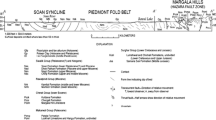Abstract
The Attock Basin is situated close to the northwest of Pakistan. Recent seismic event of October 2015 (7.5Mw) near the Pakistan Afghanistan border has proved that the area of interest is seismically active and triggered a series of aftershocks of magnitude even greater than 6.5Mw. This seismic activity has posed danger to the future of the people and infrastructure especially to the northwestern part of the country. Therefore, site response analysis is essential for estimating local site conditions in response to seismic events. Ambient noise recordings were made at 50 sites within urban and semi-urban settlements in the Attock Basin to analyze the site response of the small but densely populated basin. At each of these sites, the fundamental frequency of the soft sediments (f 0), the amplitude (A 0) of corresponding H/V spectral ratios, the thickness of soft sediment (H) lying over competent lithology, and the soil vulnerability index (K g) were studied. Results were correlated with sparsely available borehole data to enhance the credibility of the study conducted for microzonation and predicting the site response to earthquake seismicity in the Attock Basin. The soil vulnerability index was found to range from moderate to high. Results clearly showed that the study area exhibits low to moderate fundamental frequency with greater soft sediment thicknesses distributed throughout the study area. Moreover, higher impedance contrasts were found at most of the sites within the central part of the Attock Basin, thus reflecting a moderate to high susceptibility of damage in those regions in response to seismic events.









Similar content being viewed by others
References
Armbruster J, Seeber L, Jacob KH (1978) The northern termination of the Himalayan mountain front: active tectonics from micro earthquakes. J Geophys Res 83:269–282
Athanasopoulus GA, Pelekis PC, Leonidou EA (1999) Effects of surface topography on seismic ground response in the Egion (Greece) 15 June 1995 earthquake. Soil Dyn Earthq Eng 18:135–149
Bard PY (1999) Microtremor measurements: a tool for site effect estimation. In: Irikura K, Kudo K, Okada H, Sasatami T (eds) The effects of surface geology on seismic motion. Balkema, p 1251–1279
Bard PY, SESAME-Team (2005) Guidelines for the implementation of the H/V spectral ratio technique on ambient vibrations–measurements, processing and interpretations, SESAME European research project EVG1-CT-2000–00026, deliverable D23.12, available at http://sesamefp5.obs.ujf-grenoble.fr
Bonnefoy-Claudet S, Baize S, Bonilla LF, Berge-Thierry C, Pasten C, Campos J, Volant P, Verdugo R (2009) Site effect evaluation in the basin of Santiago de Chile using ambient noise measurements. Geophys J Int 176:925–937
Burbank, DW (1982) The dironologic and stratigraphic development of the Kashmir and Peshawar intermontane basins, northwestern Himalaya. Ph.D. thesis, Dartmouth College
Burbank DW, Tahirkheli RAK (1985) The magnetostratigraphy, fission-track dating and stratigraphic evolution of the Peshawar intermontane basin, northern Pakistan. Bull Geol Soc Am 96:539–552
Cotter (1933) The geology of the part of the Attock district west of longitude 72°45′ E. Memoirs of the Geological Survey of India 55:63–161
Fatmi AN (1973) Lithostratigraphic units of Kohat-Potwar Province, Indus Basin Pakistan. Geol Surv Pakistan, Memoir 10:80
Hussain A, Yeats RS (2002) Active faulting in the southern Peshawar basin, Pakistan. Geological Bulletin Univ Peshawar 35:113–124
Hussain A, Yeats RS, Pogue K (1990) Geologic map of Attock-Cherat range and adjoining areas, N.W.F.P and Punjab, Pakistan. Geol. Suv. Pak NWFP Series, 1;100.000
Jabeen S (2013) Environmental geochemistry of Attock and Haripur basins, Pakistan. PhD thesis, University of Peshawar
Konno K, Ohmachi T (1998) Ground-motion characteristics estimated from spectral ratio between horizontal and vertical components of microtremor. Bull Seismol Soc Am 88:228–241
Lane JW Jr, White EA, Steele GV, Cannia JC (2008) Estimation of bedrock depth using the horizontal-to-vertical (H/V) ambient-noise seismic method, in Symposium on the Application of Geophysics to Engineering and Environmental Problems, April 6–10, 2008, Philadelphia, Pennsylvania, Proceedings: Denver, Colorado, Environmental and Engineering Geophysical Society, 13 p
Mukhopadhyay S, Bormann P (2004) Low cost seismic microzonation using microtremor data: an example from Delhi, India. J Asian Earth Sci 24:271–280
Parolai S, Borman P, Milkereit C (2001) Assessment of the natural frequency of the sedimentary cover in the Cologene area (Germany) using the ambient noise measurements. J Earthquake Eng 5:541–564
Parolai S, Bormann P, Milkereit C (2002) New relationships between Vs, thickness of the sediments and resonance frequency calculated by means of H/V ratio of seismic noise for the Cologne area (Germany). Bull Seismol Soc Am 92(6):2521–2527
Pivinik DA, Johnson GD (1995) Depositional response to Pliocene–Pleistocene foreland partitioning in northwest Pakistan. Bull Geol Soc Am 107:895–922
Şafak E (2001) Local site effects and dynamic soil behavior. Soil Dyn Earthq Eng 21:453–458
SESAME (2004) Guidelines for the implementation of the H/V spectral ratio technique on ambient noise vibrations measurements, processing and interpretation. SESAME European research project WP12:1–62
Warnana DD, Soemitro RAAS, Utama W (2011) Application of microtremor HVSR method for assessing the site effect in residual soil slope. Int J Basic Appl Sci 11(4):73–78
Yeats RS, Hussain A (1987) Timing of structural events in the Himalayan foothills of north-western Pakistan. Geol Soc Am Bull 99:161–176
Yeats RS, Hussain A (1989) Zone of late quaternary deformation in the southern Peshawar Basin, Pakistan, in Malinconico LL Jr and Lillie R J eds., Tectonics of the western Himalayas: Geol Soc Am Spec Pap 232, 265–274
Acknowledgments
Authors are highly thankful to Mr. Zahid Rafi and Mr. Qamar Abbasi of Pakistan Meteorological Department for providing the instruments for data acquisition and processing and Mr. Phua Eng Siong of Faculty of Sciences, Universiti Brunei Darussalam for his guidance in designing the maps in article. We are thankful to Mr. Saif ur Rehman, Department of Earth Sciences, University of Sargodha for providing us with borehole data.
Author information
Authors and Affiliations
Corresponding author
Rights and permissions
About this article
Cite this article
Talha Qadri, S.M., Aminul Islam, M., Shalaby, M.R. et al. Characterizing site response in the Attock Basin, Pakistan, using microtremor measurement analysis. Arab J Geosci 10, 267 (2017). https://doi.org/10.1007/s12517-017-3057-2
Received:
Accepted:
Published:
DOI: https://doi.org/10.1007/s12517-017-3057-2




